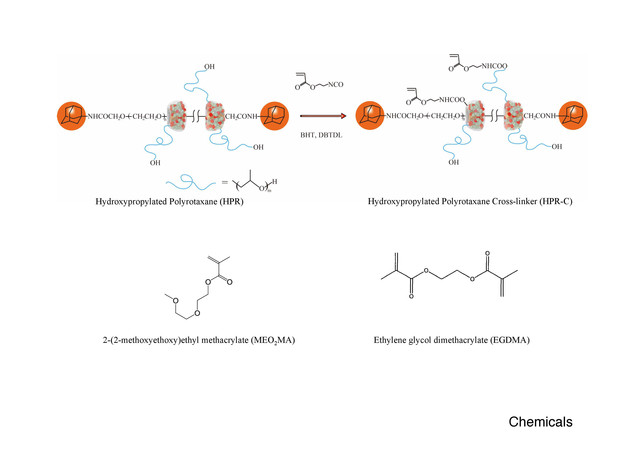Collaboration based at Nagoya University uses polyrotaxane cross-linkers to improve the performance of rubber-like polymers.
press released on October 15, 2018
Fig. 1: Photos of the HRP-C-MEO2MA elsastomer exhibiting a reversible extensibility change
Nagoya, Japan - Advanced plastics that are tough, safe, and flexible are required for use in cutting-edge applications like wearable devices and soft robots. Elastomers are plastics that consist of a three-dimensional polymer network joined by cross-linkers. These materials are attractive for such applications because of their elastic recovery; or, their ability to deform when under load and recover their original shape once the load is removed. However, it remains difficult to realize all of the desired properties of flexibility, toughness, durability, safety, and transparency in an elastomer that is easy to prepare.
A Nagoya University-led collaboration has recently developed a new type of elastomer that uses a novel cross-linking strategy to achieve improved toughness while maintaining flexibility and transparency. The team used polyrotaxane-based linkers to prepare their polymer network. Polyrotaxanes consist of molecular rings that are threaded over linear molecules to form structures that resemble pulleys. The polyrotaxane cross-linkers resulted in an elastomer that was arranged in a unique manner. When the elastomer was deformed, the polyrotaxane cross-linkers could slide along the polymer chains, which helped to dissipate energy and increase the toughness of the elastomer.
The Japanese-led collaboration confirmed experimentally that the sliding of the polyrotaxane rings contributed to the high elasticity and toughness of the elastomer.
Fig. 2: Chemical structure of the cross-linkers (HPR-C and EGDMA) and monomer (MEO2MA) used in this study
(Here only two cyclic cyclodextrin molecules are shown to avoid complexity in the scheme.)
"We investigated the movement of polyrotaxane linkers by small-angle X-ray scattering measurements," explains Hiroaki Gotoh. "Our results showed that the conformation of the polyrotaxane rings altered dramatically when the elastomer was deformed, changing from coil-like to rod-like as the deformation increased."
This conformational change indicated that the sliding of the polyrotaxane rings along the polymer chains led to the favorable performance of the elastomer. The elastomer tolerated elongation by over seven times that of a reference elastomer lacking the polyrotaxane cross-linkers. In addition, the polyrotaxane-containing elastomer displayed a fracture energy--an indicator of the mechanical toughness of a material--that was about five times higher that of the reference elastomer.
Fig. 3: Schematic diagram depicting the change in the conformation of the polyrotaxane cross-linker due to the elongation of the elastomer
(The arrow in the figure indicates the elongation direction of the elastomer.)
"Our unique polyrotaxane cross-linker overcame the trade-off between elasticity and toughness typically observed for elastomers," says Yukikazu Takeoka. "This is because the sliding motion of the rings in the polyrotaxane helped to disperse energy through plastic flow during deformation."
The developed polyrotaxane cross-linker represents a novel approach to provide elastomers with performance characteristics that meet the requirements for state-of-the-art applications like bionics and soft robots.
*****
The article "Optically Transparent, High Toughness Elastomer Using a Polyrotaxane Cross-linker as a Molecular Pulley" recently appeared in Science Advances and is available at DOI:
*****
Authors: Hiroaki Gotoh, Chang Liu, Abu Bin Imran, Mitsuo Hara, Takahiro Seki, Koichi Mayumi, Kohzo Ito, Yukikazu Takeoka
*****
Related Links:
-
Department of Molecular and Macromolecular Chemistry, Nagoya University
-
Department of Advanced Materials Science, The University of Tokyo




